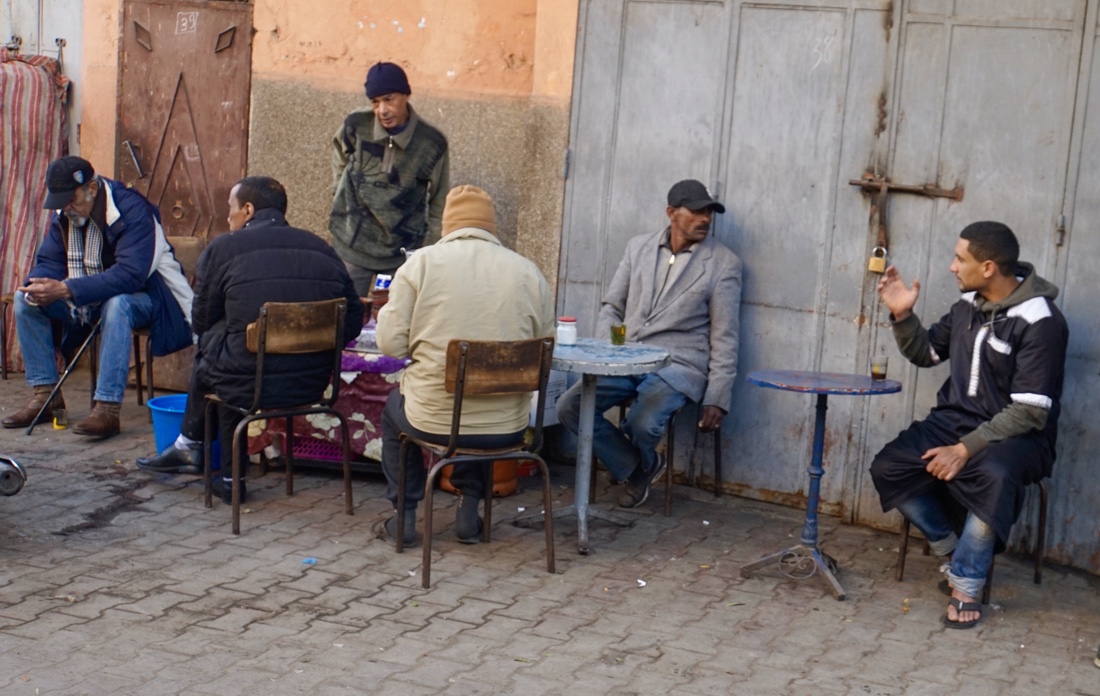March 11
Though a whole host of spots to see are listed on our itinerary, Younes decides, sensibly enough, to take us to only the best and to add a couple of interest that we’re not on the list.
Most interesting to both Carol and me are the street scenes of people going about their ordinary lives. Here are some taken at various times during the day.







 Our first stop, unscheduled, was another synagogue. No services were being conducted, but we enjoyed seeing and walking around the building.
Our first stop, unscheduled, was another synagogue. No services were being conducted, but we enjoyed seeing and walking around the building.
Next we head to the late 19th Century Bahia Palace, which is a wonderful example of Moroccan architecture. Very spectacular ceramic, plaster and tile work.



We then head to our motor bikes for an hour and a half sidecar ride around the area. We are able to get up close to local life on these Urals, the Russian knockoffs of the 1938 BMW R71 that seat two passengers per bike, one on the back and one in the sidecar. We are driven around by two French guys. I thought the sidecar rides were great fun, but Carol was less enthused.

After the sidecar ride we visit a Berber pharmacy and learn about the healing qualities of a number of oils and creams. We purchase some, including one that should make Carol look about ten years younger in photos starting tomorrow and another sure to heal some scalp itching I’ve had.
We stop for a very good lunch at a local restaurant with views of the impressive minaret of he Koutoubia Mosque, the largest mosque in Marrakech. The minaret was completed under the reign of the Almohad Caliph Yaqub al-Mansur (1184-1199) and was used as model for Giralda of Seville then for the Hassan Tower of Rabat.
After lunch we have a private showing of new work at a recently converted former bean factory. The Voice Gallery showcases local and international work, mainly by young artists, who come to create and collaborate with each other, extending boundaries and exchanging ideas and utilizing the culture and landscape of Morocco to inspire their artistic endeavors. The charming associate director of Voice Gallery shows us around and explains what the artists are saying in their work. For example, ceramic sculptures of the iconic McDonald’s arches are a commentary on what modern mass production and the search for uniformity and wealth are doing to traditional values. Carol and I are quite impressed with the gallery.
We then visited the residence and atelier of Lahrbi Charkaoui one of today’s celebrated living contemporary artists. Larbi is a Moroccan painter born in 1972. He has a degree in plastic arts, and his artistic approach is based on the hybridization of traditional Arab calligraphy and of fine arts. His characters inundate the canvases, where he occupies the space with his rounded forms. With this approach, Larbi seeks to free the Arabic letter of its orthodoxy to make it a universal sign, that belongs to cosmogony, inscribing it in an abstract kind of optical space . He does his own supports, carefully preparing the canvas, the leather or the wood. He creates striking chromatic compositions, combining furor and delicacy, darkness and acidity, brilliantly. Larbi’s work has been the object of about fifteen solo exhibitions and about twenty group exhibitions, mainly in Morocco and France.
We return to the hotel to relax for a couple hours before meeting two,friends from Evanston, Maureen and Dan Flannery, who happen to be visiting Marrakech. We have wine in a courtyard of our riad, then walk a couple blocks for an excellent dinner Le Foundouk, a restaurant Carol found online, back in a Chicago.
Carol and I return to the hotel to read, blog and retire.

Stunning photos
The siderides look like fun to me but I can see how Carol wouldn’t like em. K
Wonderful photos that convey the feel and texture of street scenes and everyday life in Marrakech!
Best.
Jan